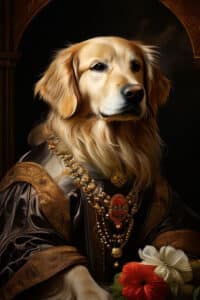Golden Retrievers in Renaissance: beautiful gallery of images created with AI.
















Golden Retrievers in Renaissance: Brief History of Renaissance Art

The Renaissance, a period of cultural rebirth that swept through Europe from the 14th to the 17th century, left an indelible mark on the world of art. This era of renewed interest in classical learning and values gave birth to a revolutionary artistic style that continues to captivate and inspire us today. In this post, we’ll explore the defining characteristics of Renaissance art and understand why it remains a pivotal moment in art history.
1. The Foundation of Renaissance Art
1.1 Historical Context
The Renaissance, meaning “rebirth” in French, was a period of immense cultural and intellectual growth. It began in Italy in the late 14th century and spread throughout Europe, reaching its peak in the 16th century. This era marked a transition from the medieval world to modern times, characterized by a renewed interest in the classical cultures of ancient Greece and Rome.
1.2 Philosophical Underpinnings
Central to Renaissance thought was the concept of humanism, which emphasized the value and potential of human beings. This philosophical shift had a profound impact on art, as artists began to focus more on depicting the human form and exploring human emotions and experiences in their work.
2. Key Characteristics of Renaissance Art
2.1 Realism and Naturalism
One of the most striking features of Renaissance art is its pursuit of realism. Artists strived to depict the world as it truly appeared, paying close attention to anatomical accuracy, perspective, and the effects of light and shadow. This marked a significant departure from the more stylized and symbolic representations of the medieval period.
2.2 Perspective and Depth
Renaissance artists made groundbreaking advancements in the use of linear perspective, creating the illusion of three-dimensional space on a two-dimensional surface. This technique allowed for more realistic and immersive compositions, drawing viewers into the painted world.
2.3 Emphasis on the Human Form
The human figure became a central subject in Renaissance art. Artists studied anatomy in great detail to accurately represent the human body in various poses and movements. This focus on the human form reflected the humanist philosophy of the time, which placed great importance on human potential and individuality.
2.4 Light and Shadow (Chiaroscuro)
Renaissance artists mastered the technique of chiaroscuro, the use of strong contrasts between light and dark to create the illusion of volume and depth. This technique added drama and realism to paintings, sculpting forms through the play of light and shadow.
3. Themes and Subjects in Renaissance Art
3.1 Religious Scenes
While religious themes remained important, Renaissance artists approached them with a new sense of humanity and realism. Biblical figures were often depicted in contemporary settings and clothing, making them more relatable to viewers.
3.2 Mythological Subjects
The renewed interest in classical culture led to a resurgence of mythological themes in art. Stories from Greek and Roman mythology became popular subjects, allowing artists to explore complex narratives and showcase their mastery of the human form.
3.3 Portraiture
The Renaissance saw a rise in the popularity of portraiture, reflecting the growing emphasis on individual identity and achievement. Wealthy patrons commissioned portraits to display their status and personality, leading to the development of new techniques in capturing likeness and character.
4. Notable Renaissance Artists and Their Contributions
4.1 Leonardo da Vinci
A true Renaissance man, Leonardo’s works like the “Mona Lisa” and “The Last Supper” exemplify the period’s focus on realism, perspective, and emotional depth. His scientific approach to art, as seen in his anatomical studies, pushed the boundaries of artistic representation.
4.2 Michelangelo
Michelangelo’s sculptures and paintings, including the ceiling of the Sistine Chapel, showcase the Renaissance idealization of the human form. His work embodies the era’s fusion of classical inspiration with Christian themes.
4.3 Raphael
Known for his harmonious compositions and graceful figures, Raphael’s works like “The School of Athens” epitomize the balance and clarity of High Renaissance art.
5. The Legacy of Renaissance Art
The innovations of Renaissance art laid the foundation for much of Western art that followed. Its emphasis on realism, perspective, and the human form continued to influence artists for centuries. The Renaissance also elevated the status of artists from craftsmen to intellectuals and creative geniuses, a concept that persists to this day.
Moreover, the technical skills developed during this period, such as oil painting techniques and the refinement of linear perspective, became standard tools in the artist’s repertoire. The Renaissance’s exploration of light, form, and space opened new possibilities in visual representation that continue to be explored and reinterpreted in contemporary art.
In conclusion, the Renaissance was a golden age of artistic innovation, characterized by a return to classical ideals, a focus on realism and the human form, and groundbreaking techniques in perspective and light. Its influence extends far beyond its historical period, shaping our understanding of art and its role in society. As we continue to study and appreciate Renaissance masterpieces, we gain not only insight into a pivotal moment in art history but also a deeper understanding of the enduring power of human creativity and expression.
All images in this post were created using AI in Playground AI. See more beautiful images of pets at AI Pawsome Art